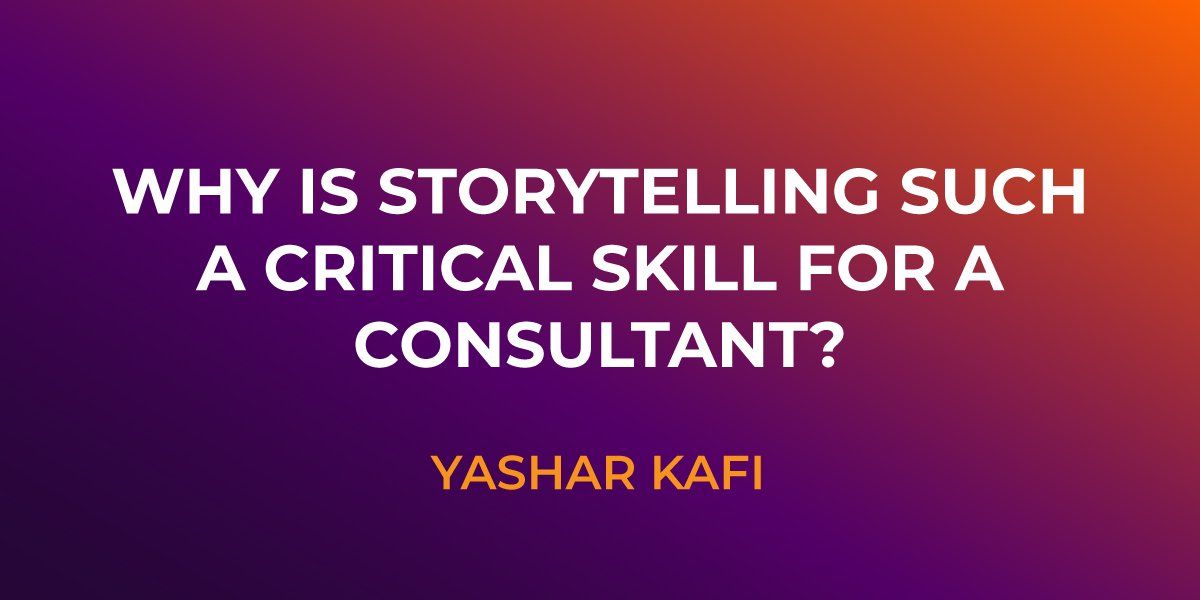Why Is Storytelling Such A Critical Skill For A Consultant?
Storytelling: It’s something we all know. It needs no introduction. From a young age, all the way up to the present day, you’ve enjoyed stories and narratives that make the boring, day-to-day repetitions a little bit more engaging. And, as we cascade towards the quarter-mark of the 21-century, every industry is looking toward the future.
What has become increasingly apparent in the age of digital disruption and global-interconnectivity is that the personal stories of influential people, business owners, and industry-leaders in most societies, past and present, play a huge role in their journey to innovate the world around them. And, in my industry, consultants are helping organizations find their feet in an infantile, technologically-enhanced world—we’re stepping in as the interim leaders, and the very best of us can tell a story. We have to.
Why is Storytelling Prevalent Now?
Statistics, figures, and revenue-streams drove the businesses of the past. Today, those variables are still prevalent, but the way that we communicate across the markets has changed—client communication is now the way of the business world. And so, consultants have had to transition from analytical to creative beings, to match the changing landscape. A necessity now is that consultants can turn those statistics and difficult to digest variables into something prettier and easier to comprehend—they must articulate the mundane with flamboyancy and flair, to ensure that they are both interesting and engaging. In essence, the best consultants have to be the best storytellers.
Can a Story Be Influential?
Absolutely. A well-told story can drive untold levels of innovation within organizations and across industries.
Think about Sir Arthur Conan Doyle’s literary creation, Sherlock Holmes—potentially the most popular detective ever. He first appeared in bookstores in 1887, and a century later, there are more than sixty books written and numerous plays, television, and film adaptations in the fictional characters’ name. Holmes’ key appeal was, of course, his crime-solving superiority and his intriguing analysis of crime scenes. A century ago, Holmes protected the scenes and used bloodstains, fingerprints, chemistry, and ballistics and formed what we now class as the foundation of crime scene forensics.
Where Can It Go?
How did Holmes influence the change? Well, storytelling is at the very core of our being. It’s the way that we make connections between the events of our life, holistically, and the unique nature of this ability has proven to be one of the most important tools that a consultant can use during the design stage of potential innovations.
Consider for a moment the way that you would take a faulty device to a tech repair shop or an engineer. You would tell a story to the retailer, explaining exactly how you came to find the fault and, with any luck, he or she would process what you’ve said, and then they’ll think of (or design) an innovative solution for your problem.
Essentially, storytelling explains who, what, why, and how something has occurred and is used by a consultant to gain an understanding of the problem that is faced in any given situation. The information or knowledge is then used to formulate and innovate a solution to rectify the issue.
I usually don’t delve into history to state the necessities of today. But ultimately, we can see from the fiction of days-gone-by just how important storytelling is or can be, for consultants—and across any industry, really. The consultant who is a storyteller can dictate the flow and narrative of the plan with ease, sparking innovation within the workplaces that they assist, while ensuring that competitors are unable to steer the plot of the modern marketplaces in their own direction.




